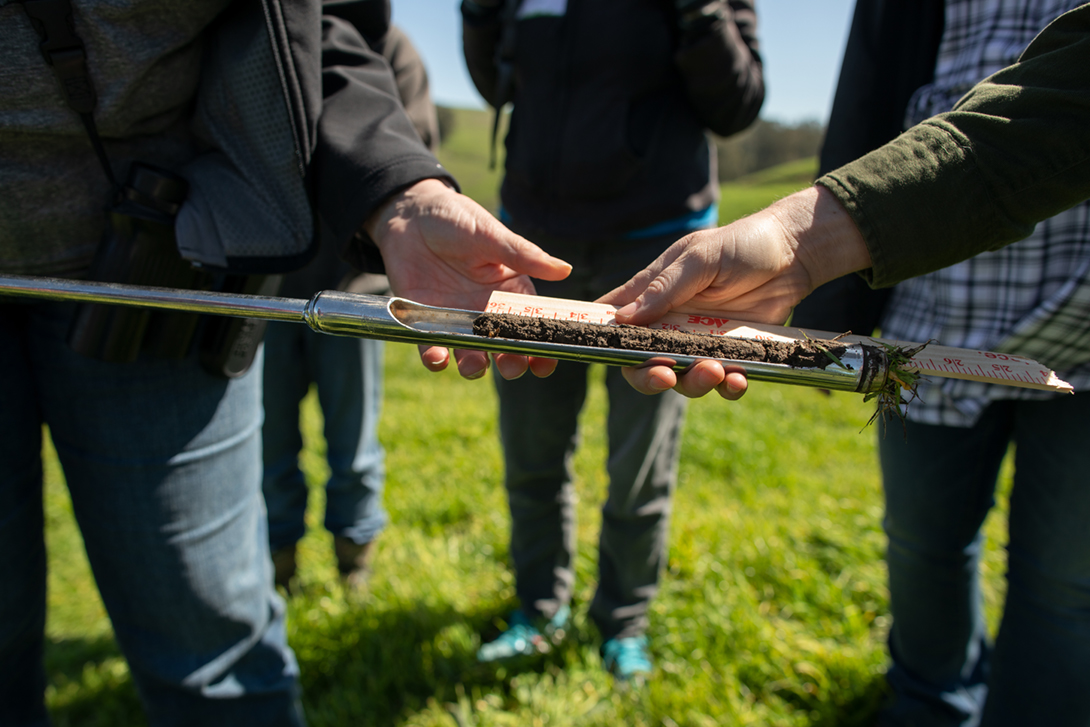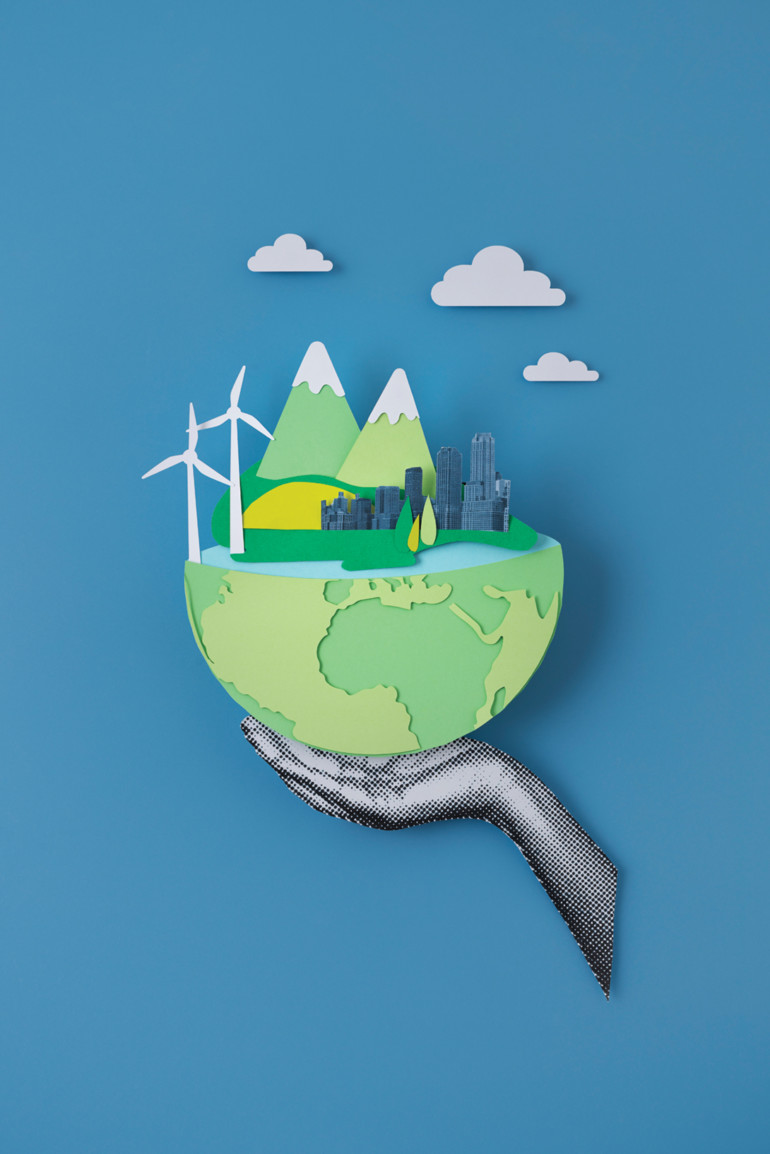DURING THE PAST YEAR, PEOPLE ALL OVER THE WORLD have been hearing a young Swede, Greta Thunberg, issue dire warnings on climate change. “Our house is on fire,” she says, and though she mostly means that figuratively, here in Marin we’re taking it literally. We all know people who’ve lost their houses as unprecedented drought and heat continue to drive firestorms like we’ve never seen before.
Scientists tell us this is just the beginning. As levels of carbon in the atmosphere increase and the growing climate crisis threatens to drastically change our lives, some in Marin are setting an example for the rest of the world, with innovative ideas and programs that can drive down emissions — and even soak them up.
Before we get too excited about our leadership, though, we need to admit that our affluent Marin lifestyle contributes disproportionately to the problem. While the average person in France is responsible for 4.3 metric tons of CO2 emissions per year, the average Marinite is responsible for almost five times as much: 20 metric tons. We are among the world’s worst carbon polluters.
The good news is that once we accept that we as individuals are responsible for our outsize carbon footprint, we can make some significant changes. Ready? Here’s a brief recap of what we in Marin can feel good about — and how we can do better.
MARIN MARIN CLEAN ENERGY (MCE)
One particularly powerful example of Marin’s environmental leadership is MCE. Formed as Marin Clean Energy in May 2010, MCE is California’s first community choice aggregator (CCA), giving Marin residents and businesses a choice in how the energy to their homes is provided. Today MCE serves more than 100,000 customers throughout Marin, three other counties, and 14 towns and cities. Its success has inspired formation of 19 other CCAs representing more than 150 communities across California.
Since MCE started service in 2010, customers have reduced over 340,000 metric tons of greenhouse gas emissions, or the equivalent of preserving 2,300 acres of U.S. forests in one year. MCE has been the single most important factor in enabling Marin to meet its 2020 carbon emission reduction targets four years ahead of schedule.
As a Marin resident, you probably get your electricity from MCE, even though your bill comes from Pacific Gas and Electric (PG&E), which is the transmission agency for MCE. Marin residents are automatically enrolled in MCE Light Green, which supplies electricity that mostly comes from renewable resources — 60 percent renewable. However, customers can “opt up” to MCE Deep Green, which comes entirely from renewable resources. The price difference is minimal — for a typical household, an extra $5 a month. Go for Deep Green and you can eliminate the carbon footprint of your electricity use. All your electricity will be coming from wind turbines or solar panels — without your having to invest in solar panels of your own.
LET’S DO THIS
Go to mcecleanenergy.org/opt-up and enroll in Deep Green. Seriously. You can just put down the magazine, track down your utility customer number from a recent PG&E bill or the website, then go to the MCE website and enroll in Deep Green — and you can be back here in five minutes to learn more, while basking in the glow of having done something significant and positive about your own carbon footprint.
DRAWDOWN: MARIN
In 2017 Sausalito resident Paul Hawken — who also founded Smith & Hawken and Erewhon — started an organization, Project Drawdown, with the mission of researching and promoting a path to drawdown, the point at which the concentration of greenhouse gases begins to decline. He compiled a top 100 list of potential ways to do this, 80 of them currently in practice, into a bestselling book to promote his findings and inspire and inform governments, other organizations and individuals worldwide.
Here in Marin, we have a local partner with this global organization. Drawdown: Marin is a community-driven campaign encouraging neighborhoods to pitch in to dramatically reduce greenhouse gas emissions and prepare for climate change impacts. Drawdown has already done the heavy lifting by citing solutions you can implement now in six focus areas: renewable energy, transportation, buildings and infrastructure, carbon sequestration, local food and food waste, and climate-resilient communities.
LET’S DO THIS
Go to the “Drawdown Marin” tab on the county’s website to learn about actions you can take in your home, your neighborhood and your larger Marin community. The Pachamama Alliance offers a 90-minute online course in all 80 Drawdown solutions on its site. Go to the Project Drawdown site or read Hawken’s Drawdown book to learn even more.
RESILIENT NEIGHBORHOODS
Ten years ago longtime Marin resident and environmentalist Tamra Peters founded a nonprofit, Resilient Neighborhoods, to help Marin households lessen their carbon footprint and prepare for emergencies. Nearly 1,000 people have reduced more than 8 million pounds of CO2 pollution every year through Resilient Neighborhoods, making it one of the most effective programs on record for driving climate-friendly behavior changes.
When households join a Resilient Neighborhoods team, they begin by running some simple calculations on a spreadsheet to measure their carbon footprint. They then attend a free five-session workshop and learn how taking simple actions like trimming energy and waste, conserving water and making smarter transportation choices can cut carbon emissions and save money. One of the classes also focuses on building neighborhood resilience against the effects of climate change, with steps like emergency planning for wildfires. At the end of the workshop series, households measure the impact of changes they made during the program.
LET’S DO THIS
Go to resilientneighborhoods.org to sign up for a climate team. If none of the signup times/dates work for you, you can create a profile via the online Marin Climate Challenge — which also begins with a measurement of your carbon footprint — at marin.goco2free.org, or check out the 90-minute online course from the Pachamama Alliance, based on Drawdown.
MARIN CARBON PROJECT

While consumption of red meat has a considerable carbon footprint, the beef and dairy cattle operations that are part of Marin’s agricultural heritage can be an important tool in reversing climate change.
The Marin Carbon Project, a free-flowing collaboration of agencies, nonprofits and individuals, under the purview of the Marin Agricultural Land Trust (MALT) has proven that grazing lands can be used to pull carbon from the atmosphere. The project began when John Wick, the co-owner of the Nicasio Native Grass Ranch and co-founder of the Marin Carbon Project in 2008, decided to run an experiment by adding a half-inch of compost to his grazed rangeland. The microbes in the compost worked to effectively pull carbon out of the atmosphere, capturing carbon and sequestering it in the soil.
“As approximately 40 percent of the earth’s land mass is rangeland and livestock grazing is the single largest land use on the planet, we thought ‘holy cow, we have something here,’ ” says Jamison Watts, executive director of MALT. These and other changes to farming practices can also result in more nutritious grass for more of the year and make farms more climate resilient.
LET’S DO THIS
Choose meat and other proteins sourced from local producers who use organic and regenerative farming methods. Opt for locally grown, in-season foods and foods not packaged in plastic. For information about local producers got to malt.org/buy-local and marincarbonproject.org.
ZERO WASTE HOME
Mill Valley mom Bea Johnson has been living a zero-waste lifestyle right here in Marin for more than a decade. She burst onto the national scene with an article about her and her family in Sunset magazine in 2010, and since then she has inspired millions to live simply and take a stand against needless waste through her book Zero Waste Home (now available in more than 25 languages), talks, TV appearances, publications and blog posts.
“We not only feel happier, but we also lead more meaningful lives based on experiences instead of stuff,” Johnson says. Her family of four generates a mere quart of waste per year through application of “the 5 Rs”: refuse, reduce, reuse, recycle and rot. The Green Awards grand prize winner of 2011, she was dubbed “Priestess of Waste-Free Living” by The New York Times and is convincing a growing number of people that waste-free living can be stylish, bring significant health benefits and save time and money.
LET’S DO THIS
Find tips and inspiration for taking action at zerowastehome.com.
WHY DO CARBON EMISSIONS MATTER?
Carbon dioxide (CO2) is a gas form of carbon that traps heat in our atmosphere. Millions of years ago, levels of CO2 in the atmosphere were much higher, but slowly decreased as plants drew carbon out of the air and locked it away over time by forming coal, gas, oil and peat. But during the industrial revolution, when we began burning coal and petroleum products and destroying forests, we started releasing that stored carbon, and the level of CO2 in the atmosphere has risen from less than 300 ppm (parts per million) before industrialization to 407 ppm today. It’s projected to reach 450 ppm by the year 2040.
The last time carbon dioxide levels were as high as they are today was in the Pliocene era, about 3 to 5 million years ago. There were no humans on earth then. The sea level was about five to 40 meters (16 to 131 feet) higher, and temperatures worldwide were much hotter than they are today.
In other words, we evolved to thrive on a planet dramatically different than the one we are creating now.
THE PLASTIC PROBLEM

Plastic accelerates the climate crisis both by adding CO2 to the atmosphere and by reducing the planet’s ability to absorb CO2 emissions. In 2019 alone, the production and incineration of plastic will add more than 850 million metric tons of greenhouse gases to the atmosphere — equal to the pollution from 189 new 500-megawatt coal-fired power plants.
Greenhouse gases are emitted at each stage of the plastic life cycle: fossil fuel extraction and transport, plastic refining and manufacture, and managing the waste once we’ve thrown the packaging away.
Most plastic is not recycled, and even recycling is problematic. So-called “compostable plastic” is not composted in Marin waste handling facilities. Instead, plastics are incinerated or left to decompose into potentially toxic microplastics, which work their way into the food we eat and the water we drink. And because microplastic contaminates plankton, it may interfere with the way plankton locks away carbon in the deep ocean, the planet’s most important drawdown process.
Here are a few more ways to save the environment, such as supporting companies that reduce waste, or finding good alternatives to plastic straws.
How to Help
For more ways to support local businesses, go here.
For more on Marin:
- Home Meal Delivery Services for Bay Area Residents Sheltering in Place
- Apps to Help You Stay in Touch
- My So-Called Shelter-in-Place Life
Anne-Christine Strugnell has been a writer for her entire professional life. After growing up in the Boston area and living for six years in England, she discovered Marin—and it was love at first sight. For the past two decades she supported herself and her family as a freelancer for hi-tech firms while also publishing personal essays in MORE Magazine, Self, the Christian Science Monitor, and the Cup of Comfort series. In 2019, awareness of the climate crisis drove her to quit her day job to focus on volunteer work with Resilient Neighborhoods and the Climate Center.


